Terahertz Refractive Index and Temperature Dual-Parameter Sensor Based on Surface Plasmon Resonance in Two-Channel Photonic Crystal Fiber
Abstract
:1. Introduction
2. Fiber Structure Design and Numerical Method
3. Results and Discussion
3.1. Dispersion Relation and Mode Coupling Characteristics
3.2. Dynamic Tunable Characteristics
3.3. Two-Channel Sensing Characteristics
3.4. Preparation Method Discussion
4. Conclusions
Author Contributions
Funding
Institutional Review Board Statement
Informed Consent Statement
Data Availability Statement
Conflicts of Interest
References
- Homola, J. Present and future of surface plasmon resonance biosensors. Anal. Bioanal. Chem. 2003, 377, 528–539. [Google Scholar] [CrossRef]
- Zhao, R.; Feng, Y.; Ling, H.; Zou, X.; Wang, M.; Lu, G. Enhanced terahertz fingerprint sensing mechanism study of tiny molecules based on tunable spoof surface plasmon polaritons on composite periodic groove structures. Sensors 2023, 23, 2496. [Google Scholar] [CrossRef] [PubMed]
- Tian, H.; Huang, F.; Xie, F.; Fu, W.; Yang, X. THz biosensing applications for clinical laboratories: Bottlenecks and strategies. TrAC Trends Anal. Chem. 2023, 163, 117057. [Google Scholar] [CrossRef]
- Hassani, A.; Skorobogatiy, M. Design criteria for microstructured-optical-fiber-based surface plasmon resonance sensors. J. Opt. Soc. Am. B 2007, 24, 1423–1429. [Google Scholar] [CrossRef]
- Wang, H.; Wang, T.; Yuan, X.; Wang, Y.; Yue, X.; Wang, L.; Zhang, J.; Wang, J. Plasmonic Nanostructure Biosensors: A Review. Sensors 2023, 23, 8156. [Google Scholar] [CrossRef] [PubMed]
- Rifat, A.; Ahmed, R.; Yetisen, A.; Butt, H.; Sabouri, A.; Mahdiraji, G.; Yun, S.; Adikan, F. Photonic crystal fiber based plasmonic sensors. Sens. Actuat. B-Chem. 2017, 243, 311–325. [Google Scholar] [CrossRef]
- Liu, C.; Lü, J.; Wang, F.; Chu, P. Overview of refractive index sensors comprising photonic crystal fibers based on the surface plasmon resonance effect. Chin. Opt. Lett. 2021, 19, 102202. [Google Scholar] [CrossRef]
- Haque, E.; Mahmuda, S.; Hossain, M.; Hai, N.; Namihira, Y.; Ahmed, F. Highly sensitive dual-core PCF based plasmonic refractive index sensor for low refractive index detection. IEEE Photonics J. 2019, 11, 1–9. [Google Scholar] [CrossRef]
- Wang, G.; Lu, Y.; Duan, L.; Yao, J. A refractive index sensor based on PCF with ultra-wide detection range. IEEE J. Sel. Top. Quantum Electron. 2020, 27, 1–8. [Google Scholar] [CrossRef]
- Zhang, J.; Yuan, J.; Qu, Y.; Qiu, S.; Mei, C.; Zhou, X.; Yan, B.; Wu, Q.; Wang, K.; Sang, X.; et al. A surface plasmon resonance-based photonic crystal fiber sensor for simultaneously measuring the refractive index and temperature. Polymers 2022, 14, 3893. [Google Scholar] [CrossRef]
- Alireza, H.; Skorobogatiy, M. Surface Plasmon Resonance-like integrated sensor at terahertz frequencies for gaseous analytes. Opt. Express 2008, 16, 20206–20214. [Google Scholar]
- Liu, S.; Ma, R.; Li, Y.; Zhao, L.; Xia, Y.; Dong, X.; Pang, Y. D-shaped surface plasmon resonance biosensor based on MoS2 in terahertz band. Opt. Fiber Technol. 2021, 66, 102631. [Google Scholar] [CrossRef]
- Zhang, Y.; Yao, Y.; Guang, Z.; Xue, J.; Wang, Q.; Gong, J.; Ali, Z.; Yang, Z. A high-sensitivity fiber biosensor based on PVDF-excited surface plasmon resonance in the terahertz band. Photonics 2023, 10, 1159. [Google Scholar] [CrossRef]
- Xue, J.; Zhang, Y.; Guang, Z.; Miao, T.; Ali, Z.; Qiao, D.; Yao, Y.; Wu, K.; Zhou, L.; Meng, C.; et al. Ultra-high sensitivity terahertz microstructured fiber biosensor for diabetes mellitus and coronary heart disease marker detection. Sensors 2023, 23, 2020. [Google Scholar] [CrossRef]
- Liu, G.; Tian, F.; Lu, Y.; Han, Z.; Yao, C.; Wang, B.; Zhang, Y.; Li, L.; Zhang, Z. Zeonex-based high sensitivity dual-channel SPR optical fiber sensor for gaseous analytes in terahertz regime. Optik 2022, 255, 168656. [Google Scholar] [CrossRef]
- Liu, S.; Li, L.; Bai, Z. Highly sensitive biosensor based on partially immobilized silver nanopillars in the terahertz band. Photonics 2021, 8, 438. [Google Scholar] [CrossRef]
- Wang, D.; Zhang, Y.; Qi, Y.; Tian, J.; Yue, S.; Ma, T. Tunable surface plasmon resonance sensor based on graphene-coated photonic crystal fiber in terahertz. Appl. Opt. 2022, 61, 6664–6670. [Google Scholar] [CrossRef]
- Wang, D.; Zhang, Y.; Tian, J.; Guo, W.; Ma, T. D-Shaped photonic crystal fiber with graphene coating for terahertz polarization filtering and sensing applications. Opt. Fiber Technol. 2023, 79, 103373. [Google Scholar] [CrossRef]
- Grigorenko1, A.; Polini, M.; Novoselov, K. Graphene plasmonics. Nat. Photonics 2012, 6, 749–758. [Google Scholar] [CrossRef]
- West, P.; Ishii, S.; Naik, G.; Emani, N.; Shalaev, V.; Boltasseva, A. Searching for better plasmonic materials. Laser Photonics Rev. 2010, 4, 795–808. [Google Scholar] [CrossRef]
- Patil, P.; Pandey, G.; Patil, A.; Vivek, V.; Deshmukh, P.; Patil, D.; Tade, R.; Nangare, S.; Khan, Z.; Patil, A.; et al. Graphene-based nanocomposites for sensitivity enhancement of surface plasmon resonance sensor for biological and chemical sensing: A review. Biosens. Bioelectron 2019, 139, 111324. [Google Scholar] [CrossRef] [PubMed]
- Zhou, X.; Li, X.; Cheng, T.; Li, S.; An, G. Graphene enhanced optical fiber SPR sensor for liquid concentration measurement. Opt. Fiber Technol. 2018, 43, 62–66. [Google Scholar] [CrossRef]
- Paul, A.; Mollah, M.; Hassan, M.; Nelson, G.; Erick, R. Graphene-coated highly sensitive photonic crystal fiber surface plasmon resonance sensor for aqueous solution: Design and numerical analysis. Photonics 2021, 8, 155. [Google Scholar] [CrossRef]
- Koshiba, M.; Saitoh, K. Numerical verification of degeneracy in hexagonal photonic crystal fibers. IEEE Photonics Technol. Lett. 2001, 13, 1313–1315. [Google Scholar] [CrossRef]
- Bao, H.; Nielsen, K.; Rasmussen, H.; Jepsen, P.; Bang, O. Fabrication and characterization of porous-core honeycomb bandgap THz fibers. Opt. Express 2012, 20, 29507–29517. [Google Scholar] [CrossRef]
- Srivastava, T.; Purkayastha, A.; Jha, R. Graphene based surface plasmon resonance gas sensor for terahertz. Opt. Quantum Electron. 2016, 48, 1–11. [Google Scholar] [CrossRef]
- Gao, Z.; Jing, X.; Liu, Y.; Chen, H.; Li, S. High sensitivity plasmonic temperature sensor based on a side-polished photonic crystal fiber. Chin. Phys. B 2022, 31, 024207. [Google Scholar] [CrossRef]
- Khanarian, G.; Celanese, H. Optical properties of cyclic olefin copolymers. Opt. Eng. 2001, 40, 1024–1029. [Google Scholar] [CrossRef]
- Hautakorpi, M.; Mattinen, M.; Ludvigsen, H. Surface-plasmon-resonance sensor based on three-hole microstructured optical fiber. Opt. Express 2008, 16, 8427–8432. [Google Scholar] [CrossRef]
- He, Z.; Li, L.; Ma, H.; Pu, L.; Xu, H.; Yi, Z.; Cao, X.; Cui, W. Graphene-based metasurface sensing applications in terahertz band. Results Phys. 2021, 21, 103795. [Google Scholar] [CrossRef]
- Hou, X.; Li, Y.; Wu, X.; He, G.; Wang, M. A thermal tunable terahertz metamaterial absorber based on strontium titanate. Phys. Scr. 2022, 97, 085507. [Google Scholar] [CrossRef]
- Yin, Z.; Jing, X.; Bai, B.; Wang, C.; Liu, C.; Gao, Z.; Li, K. A broadband SPR dual-channel sensor based on a PCF coated with sodium-silver for refractive index and temperature measurement. Results Phys. 2022, 41, 105943. [Google Scholar] [CrossRef]
- Alkeskjold, T.; Lægsgaard, J.; Bjarklev, A.; Hermann, D.; Broeng, J.; Li, J. Highly tunable large core single-mode liquid crystal photonic bandgap fiber. Appl. Opt. 2006, 45, 2261–2264. [Google Scholar] [CrossRef]
- Pan, R.; Hsieh, C.; Pan, C.; Chen, C. Temperature-dependent optical constants and birefringence of nematic liquid crystal 5CB in the terahertz frequency range. J. Appl. Phys. 2008, 103, 93523–93527. [Google Scholar] [CrossRef]
- Wang, G.; Lang, T.; Hong, Z. Metallic metamaterial terahertz sensors for simultaneous measurement of temperature and refractive index. Appl. Opt. 2020, 59, 5385–5390. [Google Scholar] [CrossRef]
- Chen, F.; Cheng, Y.; Luo, H. Temperature tunable narrow-band terahertz metasurface absorber based on InSb micro-cylinder arrays for enhanced sensing application. IEEE Access 2020, 8, 82981–82988. [Google Scholar] [CrossRef]
- Zhan, Y.; Yin, H.; Wang, J.; Yao, H.; Fan, C. Tunable multiple band THz perfect absorber with InSb metamaterial for enhanced sensing application. Results Opt. 2022, 8, 100255. [Google Scholar] [CrossRef]
- Li, Z.; Cheng, Y.; Luo, H.; Chen, F.; Li, X. Dual-band tunable terahertz perfect absorber based on all-dielectric InSb resonator structure for sensing application. J. Alloys Compd. 2022, 925, 166617. [Google Scholar] [CrossRef]
- Wu, Z.; Ng, W.; Gehm, M.; Xin, H. Terahertz electromagnetic crystal waveguide fabricated by polymer jetting rapid prototy. Opt. Express 2011, 19, 3962–3972. [Google Scholar] [CrossRef]
- Bertoncini, A.; Liberale, C. 3D printed waveguides based on photonic crystal fiber designs for complex fiber-end photonic devices. Optica 2020, 7, 1487–1494. [Google Scholar] [CrossRef]
- Chen, K.; Zhou, K.; Cheng, X.; Qiao, R.; Cheng, Y.; Liu, C.; Xie, Y.; Yu, W.; Yao, F.; Sun, Z.; et al. Graphene photonic crystal fibre with strong and tunable light-matter interaction. Nat. Photonics 2019, 13, 754–759. [Google Scholar] [CrossRef]
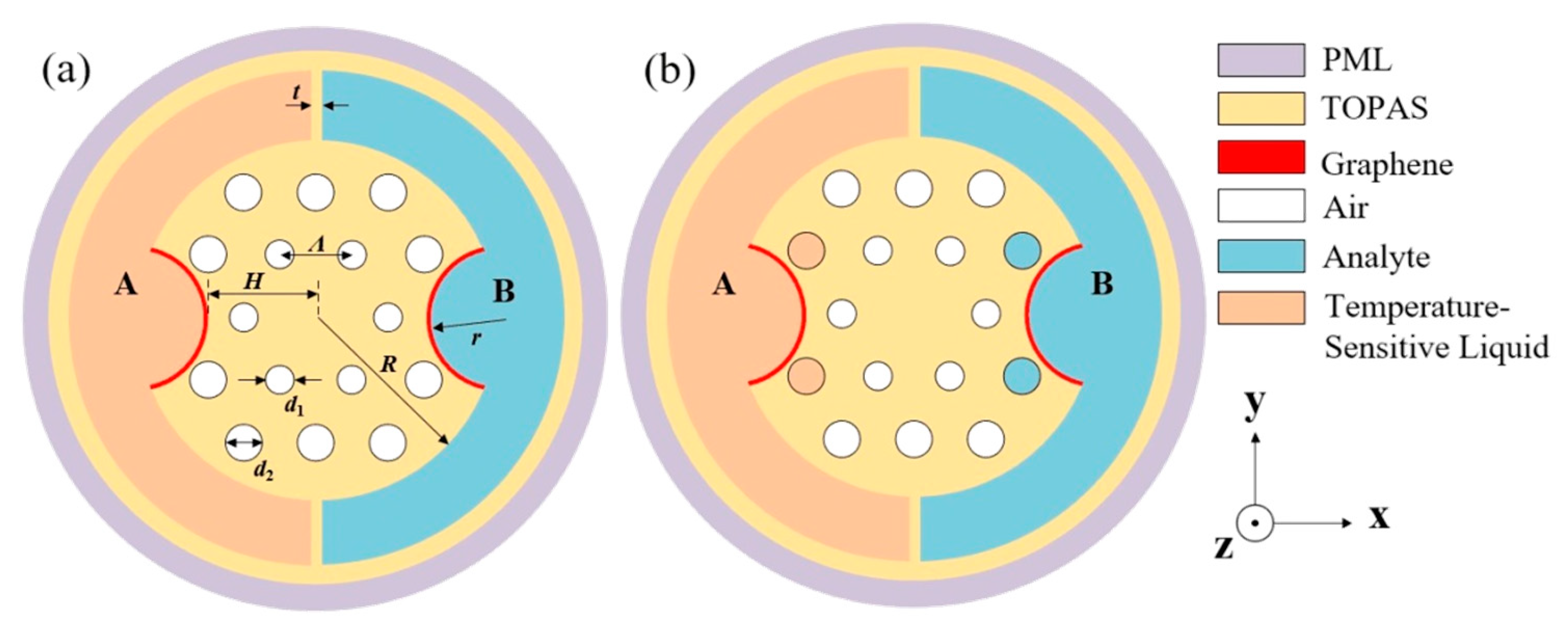

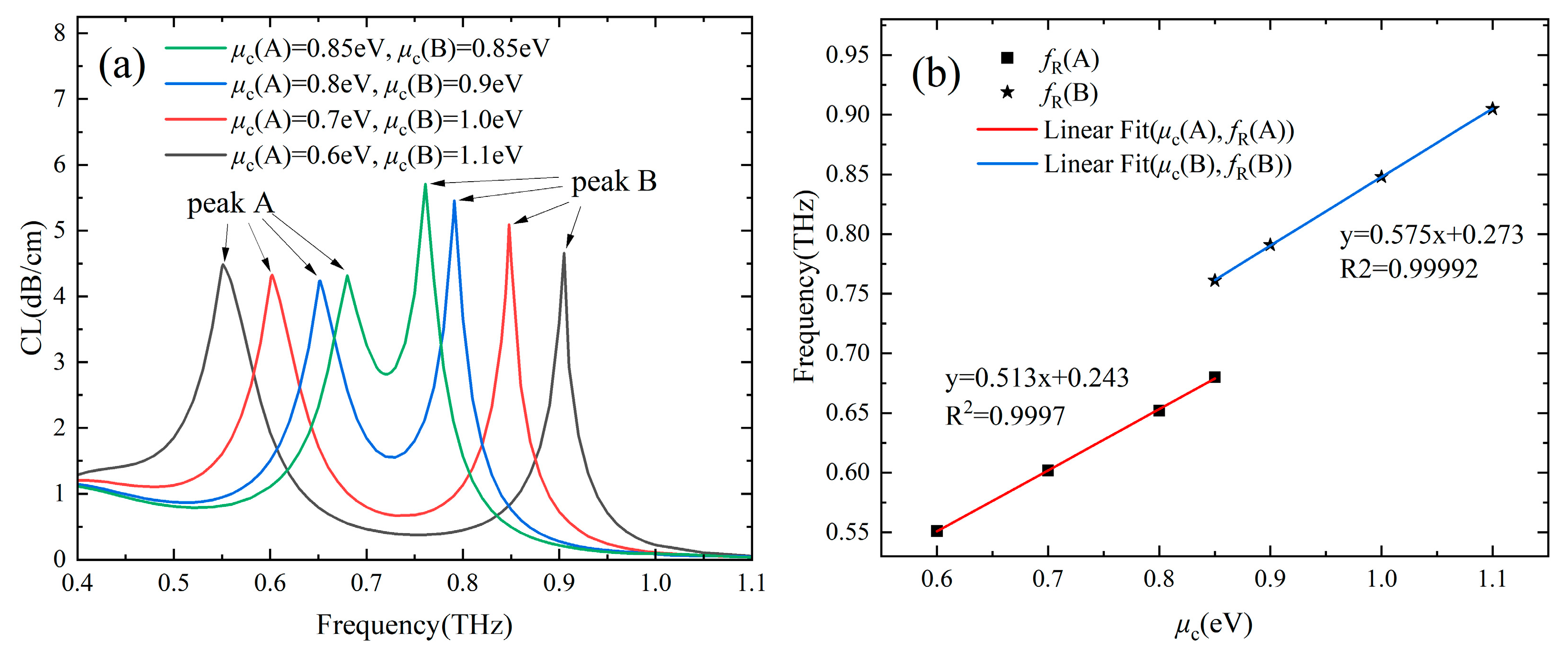
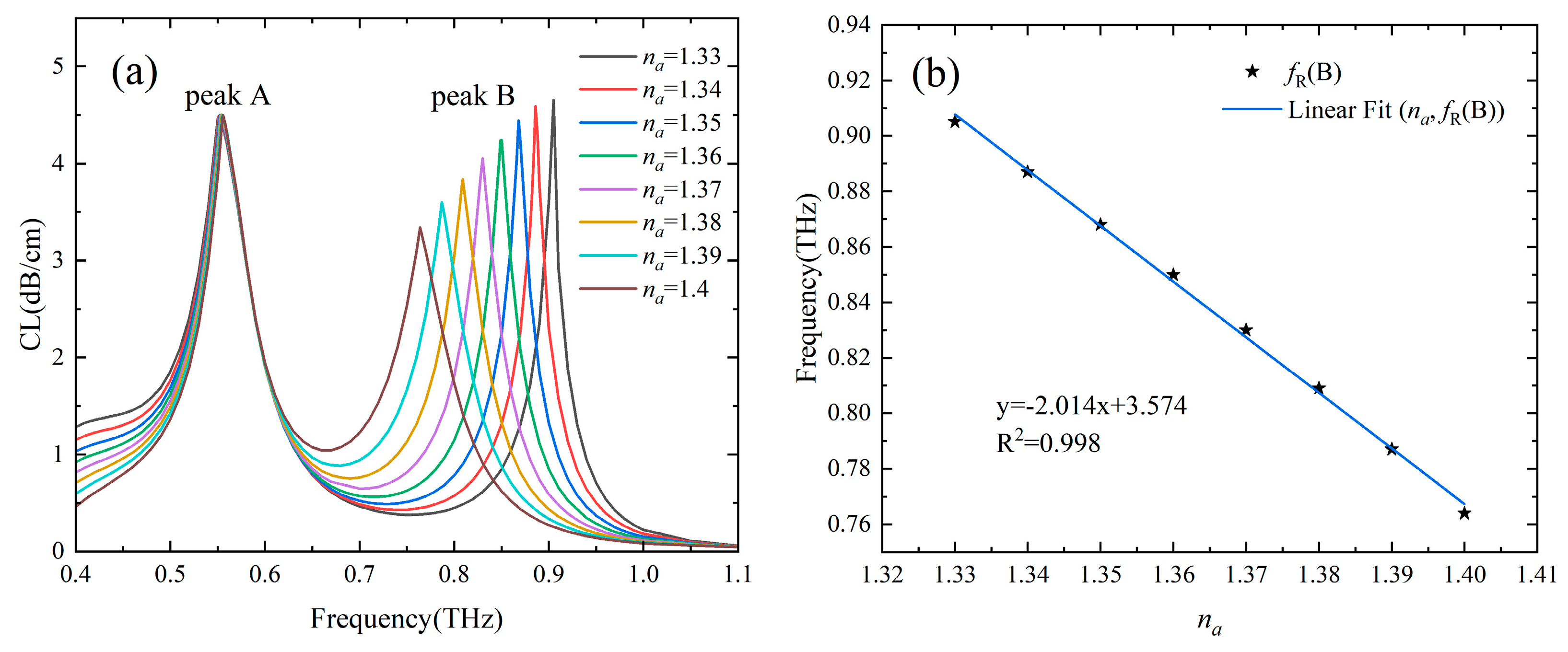
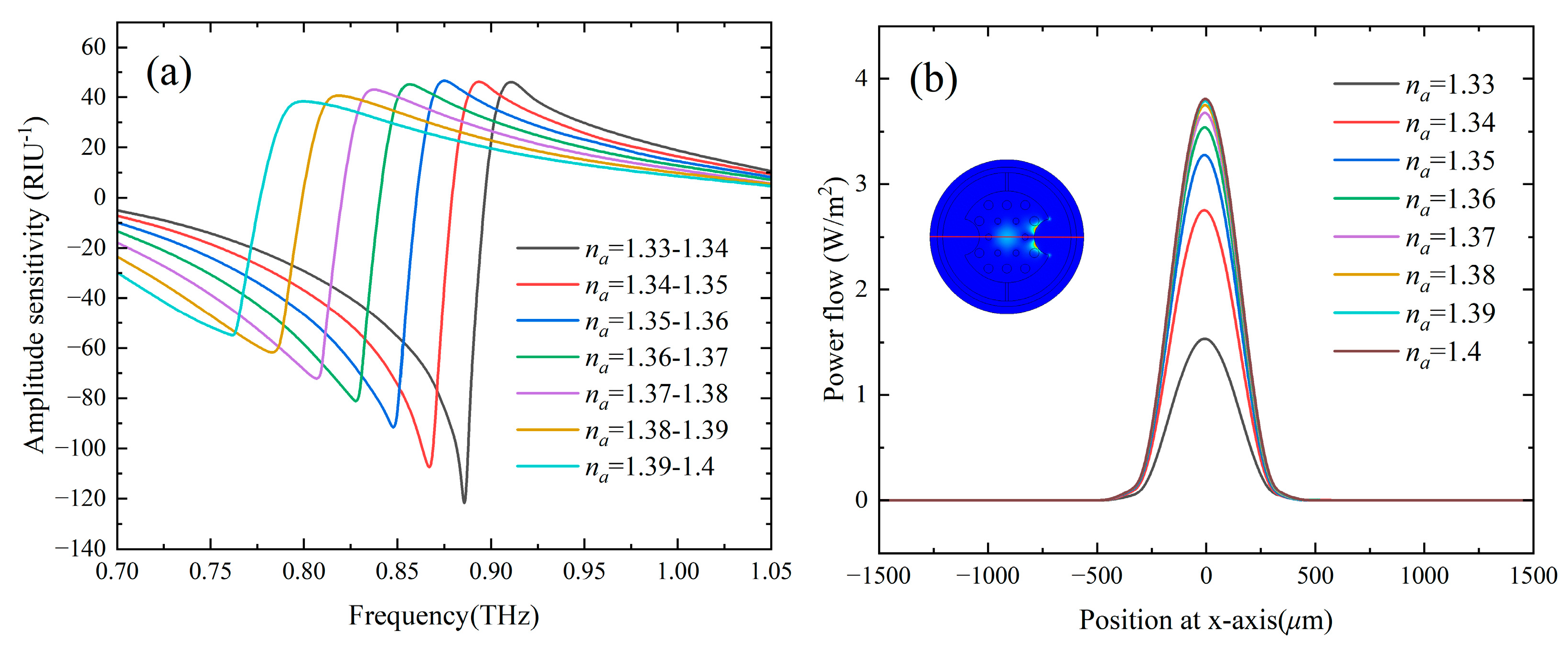
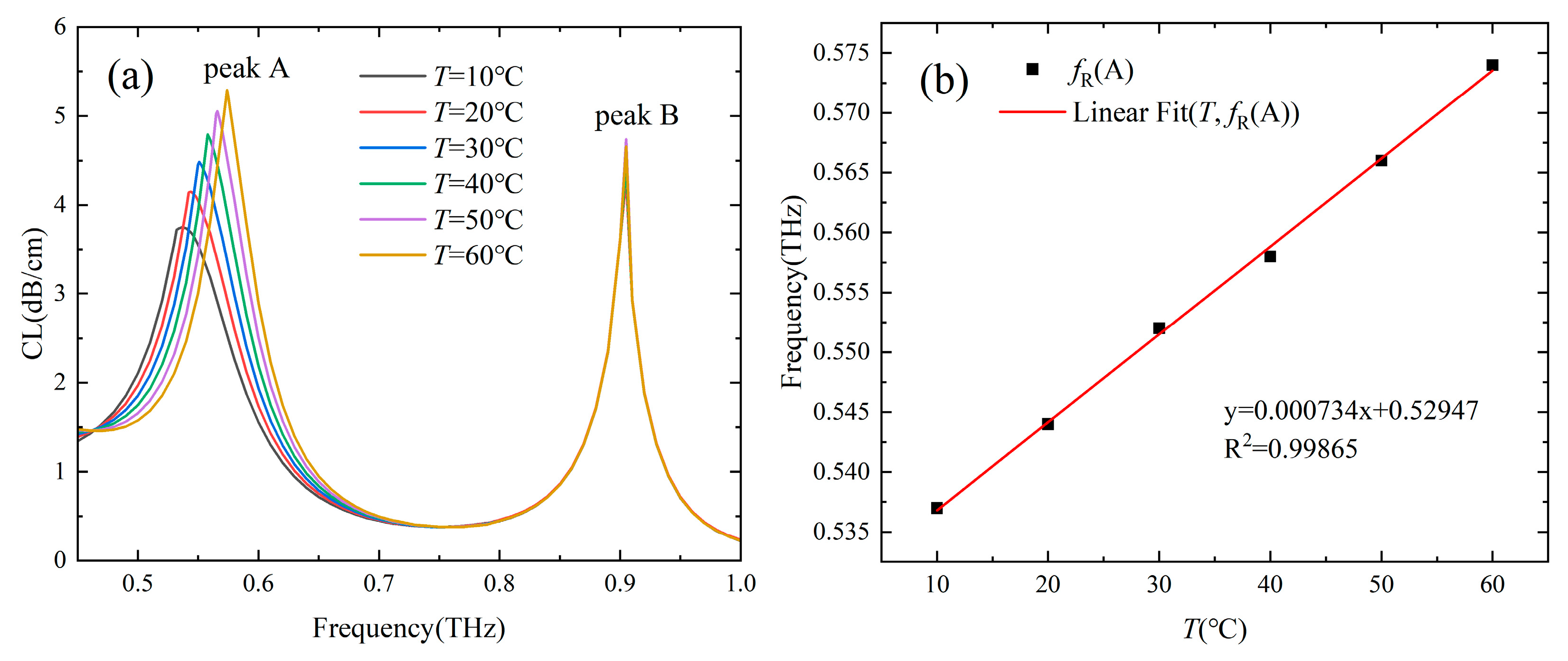

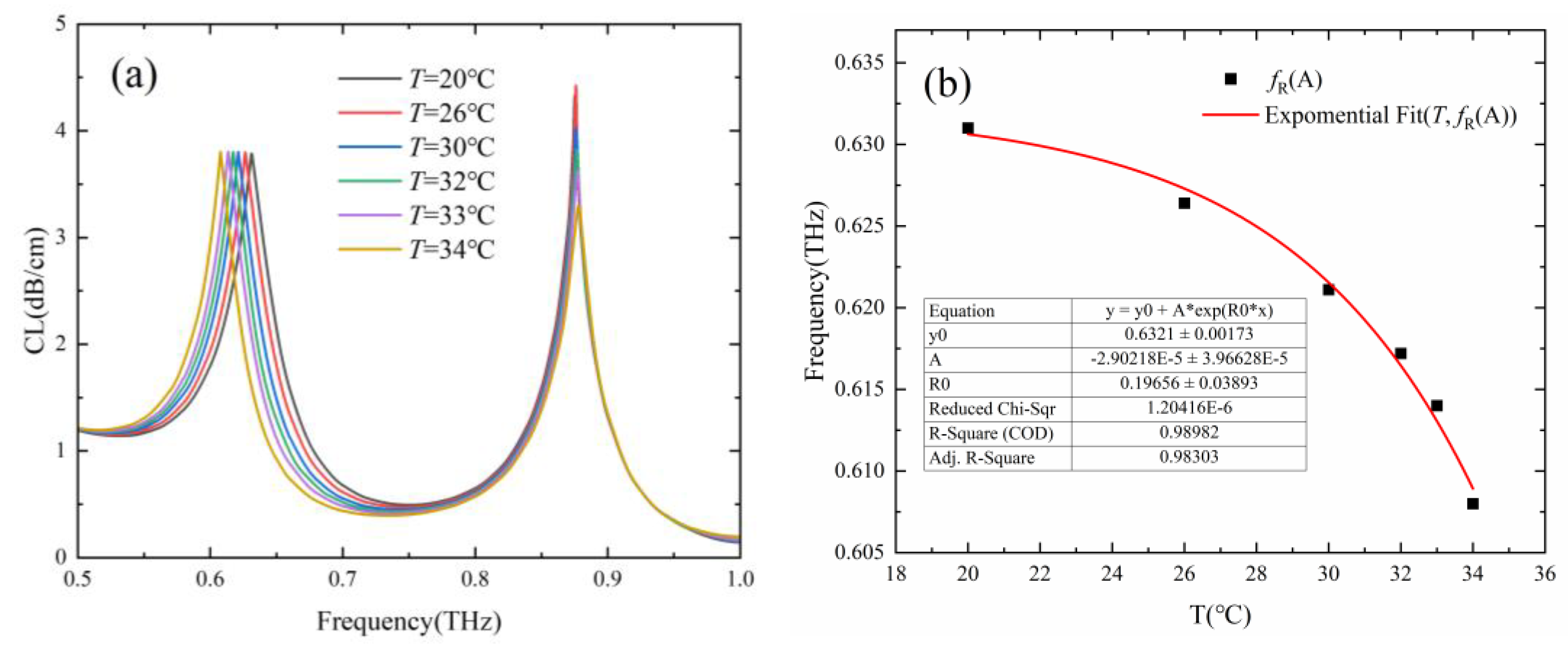
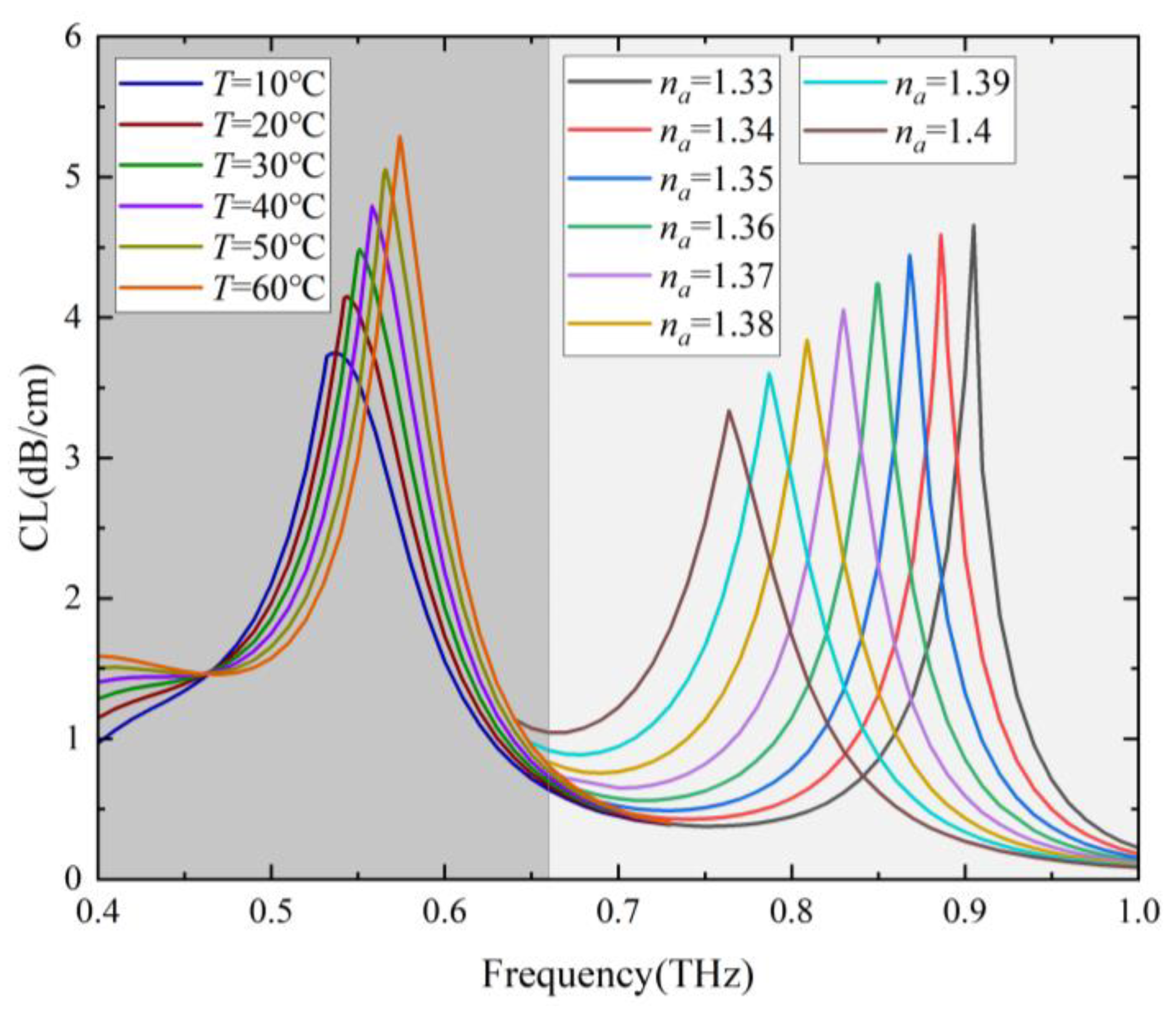

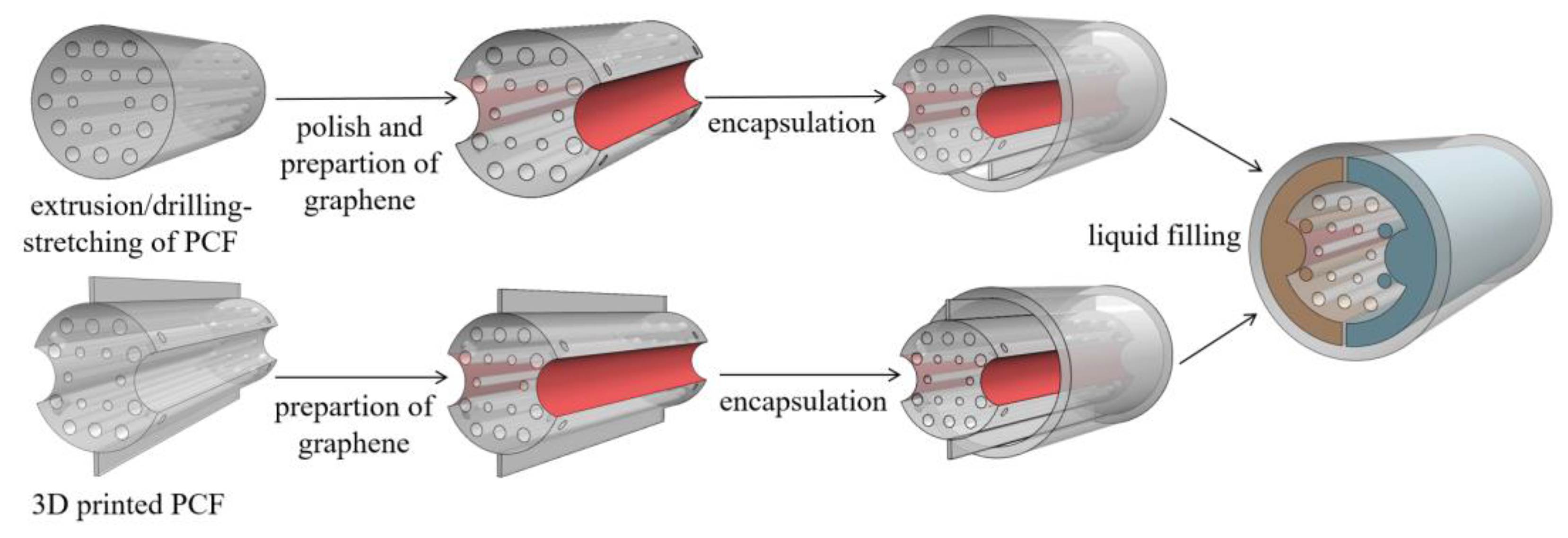
| Ref. | Sensor Structure/Plasmonic Material | Working Band | RI Range | Spectral Sensitivity | FOM (Max) |
|---|---|---|---|---|---|
| [11] | Porous fiber/PVDF | 280–320 μm | 1.0–1.01 | 400 μm/RIU | – |
| [12] | D-shaped PCF/MoS2 | 1.0–2.0 THz | 1.33–1.4 | 715.59 μm/RIU | – |
| [13] | D-shaped PCF/PVDF | 240–280 μm | 1.32–1.45 | 335.0 μm/RIU | 39.42 |
| [15] | Dual-channel porous fiber/PVDF | 300–400 μm | 1.0–1.03 | 110 μm/RIU | – |
| [16] | PCF/silver nanopillars | 1.1–1.19 THz | 1.33–1.38 | 230.16 μm/RIU 1.749 THz/RIU | 29.15 (FWHM = 0.06 THz) |
| [17] | PCF/graphene | 1.1–1.5 THz | 1.0–1.5 | 208.14 GHz/RIU | 5.82 |
| [18] | D-shaped PCF/graphene | 0.45–0.75 THz | 1.0–1.4 | 220 GHz/RIU | 6.79 |
| This work | Dual-channel PCF/graphene | 0.4–1.0 THz | 1.33–1.4 | 873.98 μm/RIU 2.014 THz/RIU | 80.2 |
| Ref. | Working Band (THz) | RI Sensitivity (THz/RIU) | FOM | Q | Temperature Sensitivity (GHz/°C) |
|---|---|---|---|---|---|
| [35] | 0.3–1.1 | 0.14 | 5.01 | – | 0.007 |
| [36] | 0.4–1.6 | 0.276 | 0.067 | – | 3.42 |
| [37] | 0.5–3.0 | 0.287 | 2.8 | 16.3 | 22.0 |
| [38] | 1.1–1.6 | 1.3 | 24.76 | 27 | 6.4 |
| This work | 0.4–1.0 | 2.014 | 80.2 | 36.2 | 0.734 6.0 (maximum) |
Disclaimer/Publisher’s Note: The statements, opinions and data contained in all publications are solely those of the individual author(s) and contributor(s) and not of MDPI and/or the editor(s). MDPI and/or the editor(s) disclaim responsibility for any injury to people or property resulting from any ideas, methods, instructions or products referred to in the content. |
© 2024 by the authors. Licensee MDPI, Basel, Switzerland. This article is an open access article distributed under the terms and conditions of the Creative Commons Attribution (CC BY) license (https://creativecommons.org/licenses/by/4.0/).
Share and Cite
Wang, D.; Guo, W.; Zou, Y.; Ma, T.; Wang, W.; Chen, G. Terahertz Refractive Index and Temperature Dual-Parameter Sensor Based on Surface Plasmon Resonance in Two-Channel Photonic Crystal Fiber. Sensors 2024, 24, 6225. https://doi.org/10.3390/s24196225
Wang D, Guo W, Zou Y, Ma T, Wang W, Chen G. Terahertz Refractive Index and Temperature Dual-Parameter Sensor Based on Surface Plasmon Resonance in Two-Channel Photonic Crystal Fiber. Sensors. 2024; 24(19):6225. https://doi.org/10.3390/s24196225
Chicago/Turabian StyleWang, Doudou, Wenchuan Guo, Yizu Zou, Tian Ma, Weifeng Wang, and Guoxiang Chen. 2024. "Terahertz Refractive Index and Temperature Dual-Parameter Sensor Based on Surface Plasmon Resonance in Two-Channel Photonic Crystal Fiber" Sensors 24, no. 19: 6225. https://doi.org/10.3390/s24196225





